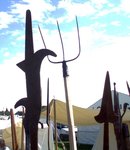trackend
Chief Master Sergeant
The Battle of Bosworth is one of the most important battles in English history.
Bosworth marked the end of the short-lived Plantagenet dynasty and the beginnings of Tudor England. With his death at the battle, Richard III became the last English king to die leading his troops in battle and the last king to have no known resting place.
By the time of the battle of Bosworth in 1485 many refinements had taken place in both tactics and weaponry.
The longbow had reached its zenith and the use of it had become well thought out.
Foot troops had become well disciplined and manuals on the use of the various weapons had been produced.
The Knight in his amour still commanded respect but was now more vulnerable than ever.
The Long bow
Made from Yew the long bow came in various lengths and pulls ranging from 70lbs to 120lbs or sometimes even 140lbs. Each served a purpose on the field of battle the high pull where the medieval sniper and would target the higher ranks to cause confusion and break the chain of command. The lower range 70lb-90lb pull was the standard rifle man of his day. In fact many arrows had angled flights this imparted a spin on the arrow for exactly the same reason as rifling in a modern firearm.
A good Bowman could have two arrows in flight and one already nocked at the same time. Multiply this by three or four thousand men and the effect can well be imagined. As with modern ammunition arrow heads varied, from the pointed Bodkin Armour piecing to the anti horse Swallowtail and many variation as technology changed. The effective range of a 120lb long bow was 250yards at this range with a Bodkin, the Knights Harness of Amour (the term SUIT (French) was an 18th century invention) could be pierced with ease.
At the battle of Crecy in 1346 the English archers found that against the angular amour of the French Knights those archers on the flanks had more effect than those in the center due to the flatter surface presented by the Knight. After this, future tactics would mean using initially, the Bodkin archers on the flanks and the Swallow and Broad head archers centrally.
Another useful lesson learned at Crecy was that the night before the battle it rained heavily the English archers unstrung their bows placing the bowstrings beneath their hats and the French Cross bowmen allowed their strings to become wet. On the day of the battle the rang of the Crossbows had dramatically been shortened and in having to move closer they became easy meat for the Archers.
This is where the saying keep it under your hatoriginates.
These images show the Bosworth battle field with Richard III standard flying on the spot where he is believed to have rallied his army.
A selection of arrow heads and a modern archer dressed in the attire of the day and using a longbow this one has a pull of 80lbs. Also a 70lb Crossbow replica. Easier to use than the long bow but much slower in rate of fire.
Below these are a re-enacting group dressed in accurate copies depicting Richard III and his subalterns in full Harnesses of Armour attended by a squire.
Bosworth marked the end of the short-lived Plantagenet dynasty and the beginnings of Tudor England. With his death at the battle, Richard III became the last English king to die leading his troops in battle and the last king to have no known resting place.
By the time of the battle of Bosworth in 1485 many refinements had taken place in both tactics and weaponry.
The longbow had reached its zenith and the use of it had become well thought out.
Foot troops had become well disciplined and manuals on the use of the various weapons had been produced.
The Knight in his amour still commanded respect but was now more vulnerable than ever.
The Long bow
Made from Yew the long bow came in various lengths and pulls ranging from 70lbs to 120lbs or sometimes even 140lbs. Each served a purpose on the field of battle the high pull where the medieval sniper and would target the higher ranks to cause confusion and break the chain of command. The lower range 70lb-90lb pull was the standard rifle man of his day. In fact many arrows had angled flights this imparted a spin on the arrow for exactly the same reason as rifling in a modern firearm.
A good Bowman could have two arrows in flight and one already nocked at the same time. Multiply this by three or four thousand men and the effect can well be imagined. As with modern ammunition arrow heads varied, from the pointed Bodkin Armour piecing to the anti horse Swallowtail and many variation as technology changed. The effective range of a 120lb long bow was 250yards at this range with a Bodkin, the Knights Harness of Amour (the term SUIT (French) was an 18th century invention) could be pierced with ease.
At the battle of Crecy in 1346 the English archers found that against the angular amour of the French Knights those archers on the flanks had more effect than those in the center due to the flatter surface presented by the Knight. After this, future tactics would mean using initially, the Bodkin archers on the flanks and the Swallow and Broad head archers centrally.
Another useful lesson learned at Crecy was that the night before the battle it rained heavily the English archers unstrung their bows placing the bowstrings beneath their hats and the French Cross bowmen allowed their strings to become wet. On the day of the battle the rang of the Crossbows had dramatically been shortened and in having to move closer they became easy meat for the Archers.
This is where the saying keep it under your hatoriginates.
These images show the Bosworth battle field with Richard III standard flying on the spot where he is believed to have rallied his army.
A selection of arrow heads and a modern archer dressed in the attire of the day and using a longbow this one has a pull of 80lbs. Also a 70lb Crossbow replica. Easier to use than the long bow but much slower in rate of fire.
Below these are a re-enacting group dressed in accurate copies depicting Richard III and his subalterns in full Harnesses of Armour attended by a squire.
Attachments
-
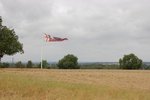 Bosworth Field.jpg51.1 KB · Views: 942
Bosworth Field.jpg51.1 KB · Views: 942 -
 LongMedievalBodkinBottom.gif9 KB · Views: 795
LongMedievalBodkinBottom.gif9 KB · Views: 795 -
 MedievalBroadheadBottom.gif8.3 KB · Views: 754
MedievalBroadheadBottom.gif8.3 KB · Views: 754 -
 MedievalSwallowtail.gif9.9 KB · Views: 797
MedievalSwallowtail.gif9.9 KB · Views: 797 -
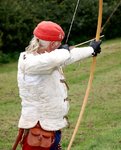 Archer of Bosworth.jpg86.7 KB · Views: 1,505
Archer of Bosworth.jpg86.7 KB · Views: 1,505 -
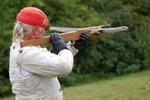 Bosworth Crossbow.jpg46.9 KB · Views: 5,134
Bosworth Crossbow.jpg46.9 KB · Views: 5,134 -
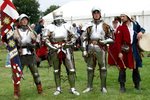 Knights of Bosworth.jpg93.4 KB · Views: 2,731
Knights of Bosworth.jpg93.4 KB · Views: 2,731

